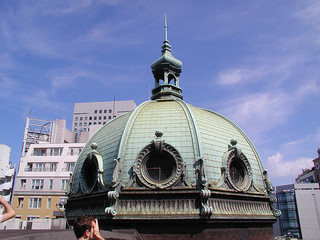Yokohama Specie Bank
- Established: 1880/2
- Other Names: 正金 (shoukin)
- Japanese: 横浜正金銀行 (Yokohama shoukin ginkou)
The Yokohama Specie Bank was a pre-war bank based in Yokohama and the largest bank in Japan specializing in foreign exchange and foreign transactions. Its former headquarters, today the home of the Kanagawa Prefectural Museum of History, has been designated an Important Cultural Property.
The bank was first established in 1880/2, with an original investment of 3,000,000 yen, following an application submitted in 1879/11 by Nakamura Michita and twenty-two others, with the support of Fukuzawa Yukichi and Lord of the Treasury Ôkuma Shigenobu. Overseas branches were opened in Bombay in 1894, Hong Kong in 1896, Tianjin in 1899, Yantai in 1900, and Beijing in 1902.[1]
Though the official headquarters of the bank remained at the Yokohama office throughout the history of the institution, after 1920, the Tokyo office took over the roles and responsibilities of headquarters in a de facto manner. The bank suffered major setbacks from the 1923 Great Kantô Earthquake, and the Shôwa Scare (Great Depression) in 1929-1930, but continued on. Its strengths in the field of foreign investment allowed the Yokohama Specie Bank to serve an important role in supporting the Imperial Japanese military during WWII, but as a result of playing this role, the bank was dismantled in 1946 by GHQ. Tokyo Bank (Tôkyô ginkô) then took over Yokohama Specie Bank's position as the dominant Japanese bank in foreign transactions; Tokyo Bank has today become Mitsubishi Tokyo UFJ Bank.
The former headquarters of the Yokohama Specie Bank, built in 1904 and designed by Tsumaki Yorinaka in a German neo-Baroque style,[2] became the home of the Kanagawa Prefectural Museum of History in 1967. Surviving buildings which used to house Yokohama Specie Bank branches in Honolulu and Shanghai are also designated as historical sites. The Honolulu branch was established in 1892 and in its early years engaged heavily in handling transfers of money sent by Japanese contract workers in Hawaii back to their families in Japan.[3]
References
- "Kyû-Yokohama shôkin ginkô honten," Kuni shitei shiseki kanzen guide 国指定史跡完全ガイド, Kodansha, 2013.
- "Yokohama shôkin ginkô," Sekai daihyakka jiten 世界大百科事典, Hitachi Solutions, 2012.
- Plaques on-site.
- ↑ Peter Duus, "Economic Dimensions of Meiji Imperialism," in Peattie and Myers (eds.), The Japanese Colonial Empire, 1895-1945, Princeton University Press (1984), 137.
- ↑ Dallas Finn, "Reassessing the Rokumeikan," in Ellen Conant (ed.), Challenging Past and Present: The Metamorphosis of Nineteenth-Century Japanese Art, University of Hawaii Press (2006), 227.
- ↑ Franklin Odo and Kazuko Sinoto, A Pictorial History of the Japanese in Hawaii 1885-1924, Bishop Museum (1985), 155.
